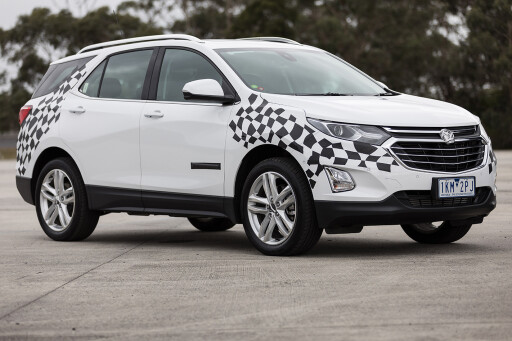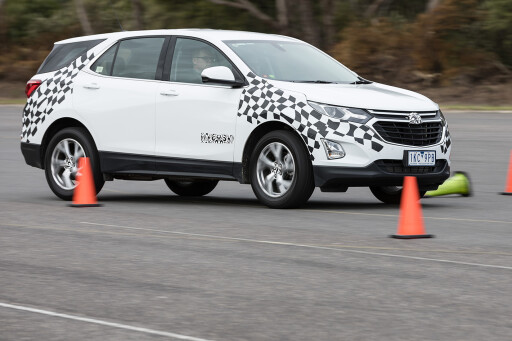
The Holden Equinox has a huge weight of expectation placed upon it.
The proposed volume player in Holden’s SUV assault, the imported sports utility has undergone a serious amount of revisions to lick it into shape for a tough Aussie crowd.
WHAT IS IT
A Mazda CX-5-sized SUV with a choice of three engines, front- or all-wheel drive, and a slick nine-speed automatic transmission, the Holden Equinox will help make up for lost share in a booming sector. Playing catch-up on a limited budget is a tough assignment, but the Equinox is not without its attractions.

WHY WE'RE TESTING IT
While taking a step forward from the Captiva wasn’t going to be overly taxing, kicking on and levelling with cars like the Mazda CX-5, the Hyundai Tucson, and the Kia Sportage is a more challenging brief. We had the chance to drive a pre-production prototype to get an early taste of what’s on offer.
MAIN RIVALS
Ford Escape, Hyundai Tucson, Kia Sportage, Mazda CX-5
THE WHEELS VERDICT
The Holden Equinox is, at present, a work in progress, but it shows promise. The 2.0-litre turbo petrol engine is its standout feature, delivering more power than an entry-level Porsche Macan, and Holden has blown the overtime budget in honing this mid-sized SUV’s dynamics. Matching the showroom glitz of key rivals might be the Equinox’s biggest challenge in a tough and crowded sector.

PLUS: Pace of 2.0T engine, sweet handling, interior space, technology inclusions
MINUS: Materials quality in cabin unconvincing, unexciting exterior styling
THE WHEELS REVIEW
There’s a strange sense of déjà vu about the launch of the Holden Equinox. Eleven years ago, Holden realised that the Suzuki-based Cruze and jacked-up Adventra weren’t convincing SUV buyers who were used to more sophisticated SUV fare like the Ford Territory and the Toyota Kluger. The answer was to import the Daewoo-sourced Captiva. At the time we seemed generally impressed by Holden’s efforts, but time wasn’t kind to the Captiva. Where its rivals evolved rapidly, the Captiva quickly became an also-ran and, latterly, an embarrassing exemplar of Holden’s developmental stasis.
Now, here’s Holden again admitting they’re behind the curve on SUVs, and the answer is to again scour the General’s portfolio for a pret-a-porter solution. The Mexican-built Chevrolet Equinox is this year’s overseas marquee signing, currently undergoing a rapid process of Australianisation at the hands of the engineering team at Lang Lang.

The Equinox is a familiar nameplate in the US, having graced the rear end of Chevy SUVs since 2004. Holden’s importing the third-generation car, downsized after the prior car never made the fuel figures claimed for it. Stung by that, the American market compensated with a smaller body and, initially at least, the sole choice of a 127kW 1.5-litre turbocharged petrol engine. Fortunately we get a bit more leeway, the engine choice here comprises of that 1.5-litre lump alongside a 100kW 1.6-litre turbodiesel and a barrel-chested 188 kW 2.0-litre turbo petrol.All will drive through a nine-speed automatic with a Range Select feature that can limit upshifts, primarily for towing.
We got to drive the 2.0-litre turbo, in this instance in front-wheel drive guise. The dynamics seem generally well-sorted, with impressive body control, low effort but accurate steering, and a supple ride. On a coned slalom course, it’s possible to feel the brake torque vectoring at work, dragging the car back into line. The 18-inch alloys featured 60-series Bridgestone Dueler rubber which helped the secondary ride considerably. On damp tarmac, there’s a surprising amount of wheelspin before the traction control intervenes, but the 2.0-litre engine has enough about it to put a grin on your face. Holden expects a 0-100km/h in the mid-7s and it feels every bit that fast. Despite in-car noise-cancelling tech, it’s not the quietest car in its class at cruising speeds. The Bose-engineered noise cancelling chiefly targets engine frequencies and not wind, tyre, and suspension noise.
Holden has had to develop three separate suspension tunes for the Equinox, one for the 1.5T, another for the front-wheel drive versions of the 2.0T and 1.6TD, and a third for all-wheel drive 2.0T and 1.6D variants. These changes include ride bush, handling bush, rear lower control arm bush, rear toe link bush, front and rear stabiliser bars, as well as damper, and steering calibration. Once these variables have been crunched, it all has to work on 17, 18, and 19-inch wheel and tyre combos. That’s quite a task. Engineer Tony Metaxas runs through some of the highlights such as the decouplable all-wheel drive, the active shutter tech in the front grille, and the two-tonne towing capacity that Holden insisted upon. “We probably did more work on this car than we were expecting,” he admits.

The cabin is where the Equinox could struggle against the best in class. The centre console in particular looks budget. The inclusion of a splash of chrome on the dash and a re-skin for the infotainment system can only do so much to lift a fairly ordinary-looking interior. It doesn’t want for standard equipment though, and although details of trim levels have yet to be released, expect to find features such as Apple Carplay and Android Auto, wireless phone charging, a hands-free powered tailgate, LED headlights, ventilated and heated front seats, and heating for the rear seats and steering wheel.
Rear seat accommodation impresses, with plenty of space for six-footers in tandem and it’s easy to drop the non-sliding rear seats using a tab in the luggage bay. The wider part of the 60/40 rear bench requires the centre headrest to be removed in order to fold fully flat and luggage space is class competitive, albeit just pipped by the Kia Sportage. The rear bench is creaky though and the front seats are a little insubstantial, with rear three-quarter visibility hampered by the big C-pillars.

The Equinox is honest, it’s solid, it does a job and fills a hole: all descriptions you could have levelled at the Captiva. Holden’s spokesman enthusiastically told us that “we’re shifting our offering to a whole bunch of SUVs.” Eleven years with the fly-in Captiva has provided Holden with a valuable case study, yet it seems that certain lessons have still to be learned. Much will depend on final specifications and pricing, but the likeable Equinox looks set to have its work cut out.
JOIN THE THRONG
The Equinox and its bigger Acadia sibling represent the 16th and 17th new vehicles as part of Holden’s aim to introduce 24 new models by 2020. These two new additions will join the Trailblazer and Trax to broaden their SUV offering to four, with other AWD choices in the shape of the Colorado ute and the Commodore Sports Tourer. “We can’t compete on volume. We need to rebuild the business and be solid and strong in the big sectors,” said Holden’s communications director Sean Poppitt.

SPECS
Model: Holden Equinox 2.0T FWD
Engine: 1998cc turbocharged dohc inline-4
Max power: 188kW @ 5500rpm
Max torque: 353Nm @ 2000rpm
Transmission: 9-speed automatic
Weight: tba
0-100km/h: 7.5sec (est)
Fuel Economy: 8.4L/100km (US-spec)
Price: $ tba
On sale: December 2017



COMMENTS